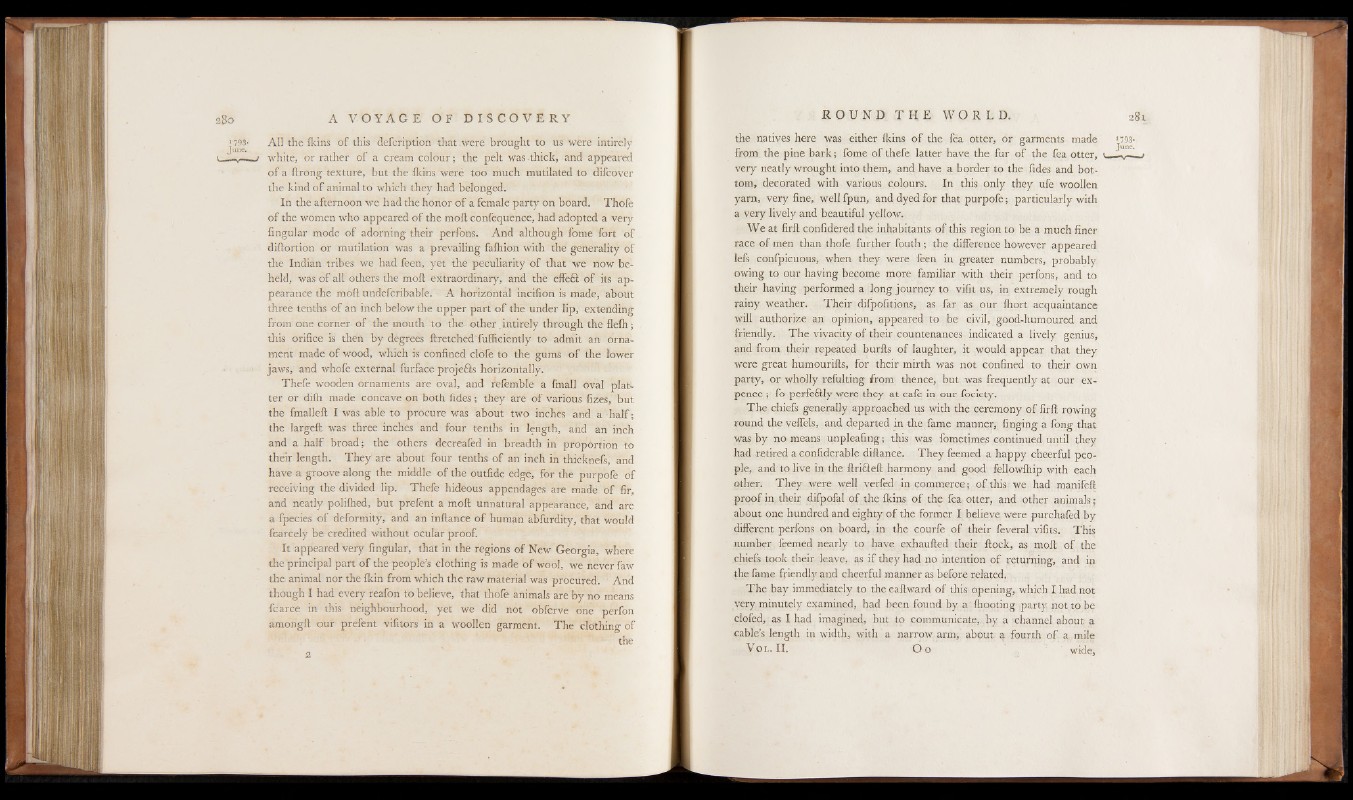
>793-
June.
All the fleins of this defeription that .were brought to us were intirely
white, or rather of a cream colour; the pelt was thick, and appeared
o f a ftrong texture, but the fleins were too much mutilated to difeover
the kind o f animal to which they had belonged.
In the afternoon we had the honor o f a female party on board. Thofe
of the women who appeared of the mod confequence, had adopted a very
Angular mode of adorning their perfons. And although fome fort of
diftortion or mutilation was a prevailing fafhion with the generality of
the Indian tribes we had feen, yet the peculiarity of that we now beheld,
was o f all others the moft extraordinary, and the effeft o f its appearance
the moft undefcribable. A horizontal incifion is made, about
three tenths of an inch below the upper part o f the under lip, extending
from one corner o f the mouth to the other. intirely through the flelh;
this orifice is then by degrees ftretched'fufficiently to admit an ornament
made of wood, which is confined clofe to the gums o f the lower
jaws, and whofe external furface projefts horizontally,
Thefe wooden ornaments are oval, and referable a fmall oval platter
or dilh made concave on both fides; they are o f various fizes, but
the fmalleft I was able to procure was about two inches and a h a lf;
the largeft was three inches and four tenths in length, arid an inch
and a half broad; the others decreafed in breadth in proportion to
their length. They are about four tenths o f an inch in thicknefs, and
have a groove along the middle o f the outfide edge, for the purpofe of
receiving the divided lip. Thefe hideous appendages are made o f fir,
and neatly polilhed, but prefent a moft unnatural appearance, and are
a fpecies of deformity, and an inftance of human abfurdity, that would
fcareely be credited without ocular proof.
It appeared Very Angular, that in the regions of New Georgia, where
the principal part of the people’s clothing is made o f wool, we never faw
the animal nor the fkin from which the raw material was procured. And
though I had every reafon to believe, that thofe animals are by no means
fcarce in this neighbourhood, yet we did not obferve one perfon
amongft our prefent vifitors in a woollen garment. The clothing of
the
the natives here was either Ikins o f the fea otter, or garments made 1793-
from the pine bark; fome o f thefe latter have the fur o f the fea otter, ■
very neatly wrought into them, and have a border to the fides and bottom,
decorated with various colours. In this only they ufe woollen
yarn, very fine, well fpun, and dyed for that purpofe; particularly with
a very lively and beautiful yellow.
We at firft confidered the inhabitants of this region to be a much finer
race o f men than thofe further fouth; the difference however appeared
lefs confpicuous, when they were feen in greater numbers, probably
owing to our having become more familiar with their perfons, and to
their having performed a long journey to vifit us, in extremely rough
rainy weather. Their difpofitions, as far as our Ihort acquaintance
will authorize an opinion, appeared to be civil, good-humoured and
friendly. The vivacity of their countenances indicated a lively genius,
and from their repeated burfts of laughter, it would appear that they
were great humourifts, for their mirth was not confined to their own
party, or wholly refulting from thence, but was frequently at our expence
; fo perfectly were they at eafe in our fociety.
The chiefs generally approached us with the ceremony o f firft rowing
round the veffels, and departed in the fame manner, finging a fong that
was by no means unpleafing; this was fometimes continued until they
had retired a confiderable diftance. They feemed a happy cheerful people,
and to live in the ftrifteft harmony and good fellowlhip with each
other. They were well verfed in commerce; o f this we had manifeft
proof in their difpofal o f the Ikins of the fea otter, and other animals;
about one hundred and eighty of the former I believe were purchafed by
different perfons on board, in the courfe o f their feveral vifits. This
number feemed nearly to have exhaufted their flock, as moft o f the
chiefs took their leave, as if they had no intention of returning, and in
the fame friendly and cheerful manner as before related.
The bay immediately to the eaftward of this opening, which I had not
very minutely examined, had been found by a (hooting party not „to be
clofed, as I had imagined, but to communicate,.by a 'channel about a
cable’s length in width, with a narrow arm, about a fourth of a mile
Y ol.I I . O o wide,